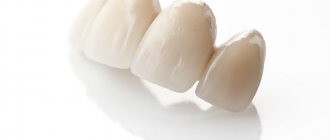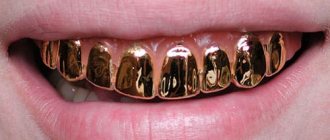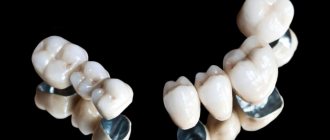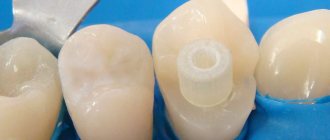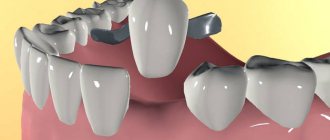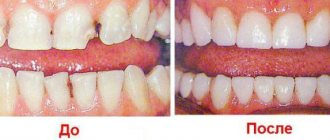Chief editor of the site:
Snitkovsky Arkady Alexandrovich
Chief physician of the professorial dentistry “22 Century”, dentist, orthopedic dentist
Author of the article:
Scientific team of dentistry “22 Century”
Dentists, candidates and doctors of medical sciences, professors
One of the classic methods of prosthetics in dentistry is gold crowns on the tooth.
One of the classic methods of prosthetics in dentistry is gold crowns on the tooth . This is a relatively inexpensive (no more expensive than metal-ceramics and ceramic crowns) option for restoring a damaged tooth, reliable and durable.
The effectiveness of prosthetics using gold crowns and their affordability make them a worthy alternative to metal-ceramics . At the 22nd Century clinic, dental prosthetics using gold crowns is widely practiced.
Do you need a pin for a crown?
If the doctor insists on prosthetics, this already means that the tooth has undergone significant destruction. The crown helps restore the chewing function of the damaged unit and the aesthetics of the smile, this is especially true for the frontal region. Obviously, the prosthesis must have the necessary support. If there is a sufficient amount of natural tissue, the crown is placed directly on the tooth. In other cases, pins and stump inlays come to the rescue.
- Tooth decay of more than 30% is a good reason for installing a pin and crown.
- A chip of one of the walls of a tooth by 50% or more or a fracture at the root are indications for installing a core inlay and crown.
The technology also has limitations. A pin cannot be placed if there is untreated pulpitis, periodontitis and their complications (cyst, gumboil, etc.). Treatment will have to be abandoned if there are abnormalities in the structure of the tooth roots (too much curvature or thin walls). In some situations, the doctor is unable to unfill the canals after previous endodontic treatment, which also affects the possibility of installing a pin.
How to care?
High-grade gold does not require special care or cleaning with expensive products. It is enough to observe standard oral hygiene: brush your teeth with your usual toothpaste in the morning and evening. For additional protection, dentists advise rinsing your mouth after eating with mouthwash or plain water. Also, visit the dentist twice a year to have your teeth examined for diseases, assess the condition of your crowns, and have your mouth professionally cleaned.
Inlay or pin: which is better?
The choice of support element depends on the specific clinical case. Both the pin and the core tab perform similar functions. However, each solution has its own advantages and disadvantages.
| Crowns on pins | Crowns on core inlays |
|
|
The stump tab is considered a more reliable option for chewing teeth and if it is necessary to install bridges. It is important to understand that this significantly increases the cost of treatment (the price per tab can reach up to 10,000 rubles). In addition, the manufacture of a stump insert requires an additional laboratory stage and appropriate manipulations.
Placing a crown on a pin can be recommended if the tooth does not have serious damage and there is no risk of pin breakage and root canal injury under the influence of chewing load. However, not all pins are suitable for the restoration of anterior teeth, especially if metal-free crowns are used. The crown and post on the front tooth should not contain metal if you want good aesthetics.
When installing a ceramic crown on a front tooth, the core inlay should also be made of ceramic.
Features of metal-plastic crowns
The design is based on a metal base. An aesthetic layer of plastic is applied to the surface of the metal crown. This can be a single crown or a structure consisting of several elements - a bridge. In the second case, several crowns are combined together and can replace from one to three teeth in a row.
The design can be stamped or cast. The second option is more reliable and durable. Cast crowns are made from impressions taken from teeth prepared for prosthetics. Unlike stamped crowns, cast crowns allow you to choose the color of the coating and ensure a reliable fit to the tooth stump.
In terms of strength, such crowns are inferior to similar products made from metal ceramics. The problem is the fragility of the plastic. The basis, as a rule, is an alloy of cobalt and chromium. Alloys of precious metals can also be used for this.
PROMOTION
Installation of crowns, dental bridge
RUB 3,450
Filling on a pin or crown: which is better?
This question interests many patients, and the answer is obvious. From the point of view of strength and reliability, the best option would be to install a pin and a crown. It is better to place a pin in a tooth under a crown in cases where the tooth is significantly damaged, especially when it comes to molars. A pin with a filling is installed for less significant damage and most often on the front teeth. This method also has its advantages. Firstly, this is a much cheaper technique. Secondly, all treatment takes place in one visit. The patient quickly returns to normal life and forgets about his problem. However, a filling with a pin gives a less reliable and predictable result.
Indications for installation
Prosthetics are prescribed by the attending physician in cases where:
- you need to straighten a crooked tooth or change its size/shape/shade;
- fluorosis was detected;
- the inflammatory process damaged more than half of the coronal part of the tooth, and the pulp was removed;
- there is a need to restore a damaged or lost tooth;
- Due to the incorrect location and size of the teeth, dental anomalies are observed. Contraindications include:
- advanced stages of periodontal disease;
- allergic intolerance to the material used;
- malocclusion;
- thinned tooth walls;
- low location of the coronal part of the segment.
Stages of installing a crown on a pin
- Initial consultation, determination of indications and contraindications for treatment.
- Preparation of tooth tissues and depulpation of root canals.
- Installation of the pin.
- Taking impressions or 3D modeling. Sending the results to the laboratory to make a permanent crown. Immediately after the procedure, the patient is offered a temporary crown.
- Trying on the finished product and fixing the crown with a pin.
Stages of prosthetics
The use of silver alloys does not affect the sequence of the prosthetic process itself:
- Preparing for the founding process. Its role can be played by either a living tooth (which is ground down) or its root (which is strengthened with a pin or stump insert).
- Taking dental impressions.
- Creation of a prosthesis. It starts with making a frame from a silver alloy, which is then coated with a thin layer of ceramic. Its tone is selected in accordance with the tone of natural teeth.
Service life and design reliability
The service life of a crown on a tooth on a pin is quite decent if the treatment was carried out efficiently, and the patient avoided injury and followed the doctor’s recommendations. Even a classic metal-ceramic crown with a simple anchor pin costs on average 7–8 years. A more expensive ceramic crown on a fiberglass post will last even longer.
If during use the crown begins to wobble, then this is a bad sign, regardless of whether it is with a pin or without a pin. In this case, you need to consult a doctor as soon as possible. If the crown and pin fall out completely, this may be due to improper treatment, pathological processes in the root canals, or a banal injury. Repeated treatment in most cases is no longer possible.
Prices for partial dentures
The absence of several units in the dentition can be compensated for by removable dentures , among which the most famous are the following:
Acrylic, nylon and polypropylene plate prostheses. They have approximately the same quality, but acrylic is harder. Not the most comfortable and reliable designs, but their prices suit many patients - a prosthesis for one jaw costs from 14 thousand rubles. If you need to replace a small number of teeth, the price may be slightly lower.- Clasp dentures. Higher quality structures that are fixed in different ways in the oral cavity, which leads to a wide variety of prices - from approximately 20 to 90 thousand rubles.
- Immediate dentures. If one or two front or back teeth are temporarily missing, the dentist can install a butterfly denture. It is short-lived, but lasts long enough to last until a permanent dental implant is inserted. The cost is varied: cheap ones - from 3 thousand rubles, higher quality ones - from 12 thousand rubles.
Clasp dentures are an expensive pleasure, especially if you choose the highest quality materials and fasteners. With sufficient financial resources and in the absence of contraindications, preference is often given to this method of prosthetics.
How much does it cost to put a crown on a post?
The price of the finished solution directly depends on the materials of the pin and crown. The cost of a regular anchor pin is 500 rubles, but for a fiberglass one you will have to pay more than 1000 rubles. But these figures pale in comparison with the range of prices for crowns. If ordinary metal-ceramics costs 6–8 thousand, then products made of ceramics and zirconium will cost three times more. All preparatory manipulations will need to be added to the final amount.
An E-Max ceramic crown on a fiberglass pin, together with all stages of treatment, can cost 30,000 rubles and even more if we are talking about a VIP-class clinic. You can also choose a budget option with a metal-ceramic crown and an anchor or titanium pin. This solution will cost from 12,000 rubles, but is not suitable in all cases.
Cost of bridges
Prosthetics can be performed using bridge structures that affect several teeth. At the edges they are attached to natural teeth or dentures; in the middle there are artificial crowns, which can be in tight or loose contact with the gums in the interdental space.
In modern dentistry, the following types of bridges can be made:
Adhesive bridge prosthesis. The cheapest method of prosthetics, in which the dentist makes a structure directly in the patient’s mouth, applying a composite material fixed with fiberglass thread or wire. Fixation with fiberglass and dental glue is not used when restoring chewing teeth, as it is fragile. Such prosthetics can cost 8 thousand rubles.- Metal-ceramic cast bridge made of cobalt-chrome alloy. Can cost from 18 thousand rubles.
- Ceramic bridge prosthesis. Such structures are made only from zirconium dioxide; porcelain is not suitable for these purposes. Such bridges are not installed on chewing teeth, since they are inferior to metal-ceramics in strength and durability, although they look more natural. Prosthetics with ceramics will cost at least 50 thousand rubles.
A plastic bridge can be installed as a temporary prosthesis. It is short-lived, but suitable for people with allergic reactions to other materials. Each plastic crown installed on one tooth costs from 1 thousand rubles.
How is the rehabilitation period after installation of a prosthesis?
During the period of soft tissue recovery after prosthetics and the patient’s adaptation to the structure, some problems may arise. For example, a denture may interfere with the usual closing of the jaws (due to the long-term absence of a tooth of normal anatomical shape). In some cases, gum inflammation, pain, and redness may occur. In general, this is all normal, since the doctor treated the tooth, the gums were injured, because it was necessary to align the position of the mucous membrane along the contour of the crown. But if the discomfort not only persists, but intensifies, you should tell your doctor about it. And as soon as possible.
You can avoid unpleasant sensations if you follow a gentle regimen in the first days after installing the prosthesis: gently brush your teeth with a soft brush, eat pureed food.
%akc72%
Alternative solutions
The only alternative to a metal-plastic prosthesis at the first stage of prosthetics after installation of implants can only be a ceramic-composite prosthesis. In general, the final cost of basal implantation using both types of structures is identical. Those. when undergoing re-prosthetics, the patient will have to pay an additional 150 thousand rubles (depending on the material) for the manufacture of a permanent prosthesis. Therefore, the only difference is the necessity or absence of the second stage of prosthetics, as well as the amount that will have to be paid immediately at the time of concluding a contract for dental implantation.
Caring for metal-plastic crowns
The rules for caring for a metal-plastic prosthesis are as follows:
- Eliminate nuts, seeds and any other solid foods from your diet.
- Minimize the consumption of beets, carrots, currants, red wine and other products containing natural or artificial colors.
- Maintain good oral hygiene.
On average, dentures of this type significantly change color and lose functionality after 2-3 years, after which they require replacement to avoid problems with the supporting teeth or implant. However, if you follow the rules of care, the service life can be extended to 5 years.
The cost of restoring teeth with inlays and veneers
If the tooth is not completely destroyed, but the filling cannot restore its appearance and function, you can make an inlay from metal or ceramic.
| Type of tab | How much does it cost to insert an inlay into one tooth (thousand rubles) |
| Made from pressed porcelain mass | From 11 |
| Cobalt-chromium | From 3.5 |
| From zirconium dioxide | From 14 |
| Golden | Depends on current gold prices and the weight of the tab |
Small defects can be corrected with the help of overlays on the front tooth surface - veneers. Such plates are suitable for improving the appearance of the front teeth, as they are not too durable, but very aesthetic.
Ordinary veneers cost from 20 thousand rubles. While their improved, thinner and more beautiful analogues - lumineers - can cost twice as much. If the pads deteriorate, they are not replaced. In this case, there is only one thing you can do - install a crown.
Dental tab
Veneer
Restoration of ceramic crowns
Despite the strength of modern ceramic dentures, the query “The ceramic has broken off from the crown, what should I do?” found on the Internet quite often. Typically a defect occurs for the following reasons:
- injury - blow or fall;
- defects in the work of a dental technician;
- malocclusion, bruxism;
- strong mechanical impact on the structure during chewing.
There are two possible solutions to the problem - replacement and restoration.
- Replacement of prosthesis. The crown is removed from the mouth, and the entire prosthetic process is repeated from the moment the impressions are taken until the new structure is attached.
- Restoration. The chip on the ceramic crown is polished to the optimal shape, and a light-curing composite material is placed into the cavity. After hardening, the specialist models the coating, forms bumps and fissures, and grinds uneven edges to the desired size.
The advantages of repair are short time and low cost; chipped ceramics on the crown can be restored in an hour in the dentist’s chair. However, even the use of the most modern materials does not provide the quality that is obtained when making a prosthesis “from scratch” in a dental laboratory. If the cause of the chip was carelessness when chewing hard food, after repair the denture will last for many years. Malocclusions and other pathologies of the dental system reduce the service life of the restored crown several times.
Crown manufacturing technologies
There are several options for manufacturing technologies for metal-free ceramics. Each of them has several features.
Type 1: firing of ceramic mass on a model
The ceramic mass is exposed to high temperatures in a vacuum. Until now, the firing process was carried out on platinum foil. Today, production occurs using a model in which phosphates are added. This increases the material's resistance to high temperatures and reduces material costs for production. Among the advantages of the technology are speed of production, accuracy, and the ability to achieve the desired shade.
Type 2: production by centrifugation
The frame is cast using centrifugation: the ceramic mass, accelerating, enters the mold and is then fired. The advantage of the method is the complete absence of porosity of the material and the possibility of precise polishing. Among the disadvantages are the technical complexity of manufacturing. In addition, bridges cannot be made using this technology.
Type 3: pressing (for Empress E.Max technologies)
Pressing is the process of shaping a material under pressure at high temperature. The crown is made on the basis of a wax structure. The resulting product has high aesthetic qualities, fits precisely to the support, and is resistant to wear. The technology is used for the manufacture of ceramic crowns with or without a frame.
Type 4: ceramic blank milling (CAD/CAM)
It is possible to achieve high precision of a pressed ceramic crown and reduce its production time using CAD/CAM technology. Using a CAD system with an intraoral scanner (or after scanning the resulting impressions), the doctor enters the received data into the computer and receives a future project (electronic impression), and the CAM system prepares the manufacture of the prosthesis by milling based on the received project. All information is sent to milling equipment, where the final design is created from blanks.
Cost of metal-free crowns
| Name | Price from |
| Consultation with an orthodontist (included in the manufacturing cost when ordering a crown) | 500 rub. |
| Cost of a metal-free crown | 20,000 rub. |
The Denta Labor dental laboratory produces all types of crowns, as well as removable and fixed dentures. You can seek advice and clarify prices for the manufacture of a particular product by calling us at the numbers listed in the “contacts” section. We employ the best specialists who are experts in their field and professionals in their field. In the manufacture of structures, we use the most modern equipment and innovative technologies. The use of the highest quality materials guarantees long service life and structural strength. Contact us for a beautiful smile!
